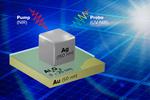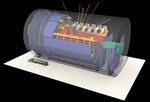Other

“In a new study, researchers from the U.S. Department of Energy’s (DOE) Argonne National Laboratory have determined that electrons in some oxides can experience an “unconventional slowing down” of their response to a light pulse. The researchers describe …

“Commercially available since the 1970s, the lithium-ion battery is now the workhorse power source in many applications. It can be found in cell phones, laptops and electric vehicles. Yet, much about the basic science taking place at the atomic and …

“A team of scientists from across the U.S. has found a new way to create molecular interconnections that can give a certain class of materials exciting new properties, including improving their ability to catalyze chemical reactions or harvest energy …

“In a new study, researchers from the U.S. Department of Energy’s (DOE) Argonne and Brookhaven National Laboratories observed the formation of two kinds of defects in individual nanowires, which are smaller in diameter than a human hair. These …

“It’s a popular tradition to throw coins into fountains in the hopes of having wishes granted. But what would happen if you could “throw” electrons into the water instead? That is, what happens shortly after an electron is injected …

“By exploiting the properties of neutrons to probe electrons in a metal, a team of researchers led by the U.S. Department of Energy’s (DOE) Argonne National Laboratory has gained new insight into the behavior of correlated electron systems …

“Solar and renewable energy is getting hot, thanks to nanoscientists — those who work with materials smaller than the width of a human hair — at the U.S. Department of Energy’s (DOE) Argonne National Laboratory who have discovered new, better …

“Defect spins in diamond were controlled with a simpler, geometric method, leading to faster computing. Quantum computing could solve problems impossible for today’s supercomputers. The challenge for this new form of computing is processing the quantum bits (qubits) that …

“Even as the power of our modern computers grows exponentially, biological systems — like our brains — remain the ultimate learning machines. By finding materials that act in ways similar to the mechanisms that biology uses to retain and process information, scientists …

“Particle collision experiments at CERN’s Large Hadron Collider (LHC)—the world’s largest particle accelerator—will generate around 50 petabytes (50 million gigabytes) of data this year that must be processed and analyzed to aid in the facility’s …

“A new material shows promise for batteries that store electricity for the grid. The material, created by scientists at the U.S. Department of Energy’s (DOE) Argonne National Laboratory, consists of carefully structured molecules designed to be particularly electrochemically …

“Researchers from The Hebrew University of Jerusalem, Stony Brook University, and the U.S. Department of Energy’s (DOE) Brookhaven National Laboratory have discovered new effects of an important method for modulating semiconductors. The method, which works by creating open …

“Imagine you were able to solve a problem 50 times faster than you can now. With this ability, you have the potential to come up with answers to even the most complex problems faster than ever before. Researchers behind the …
